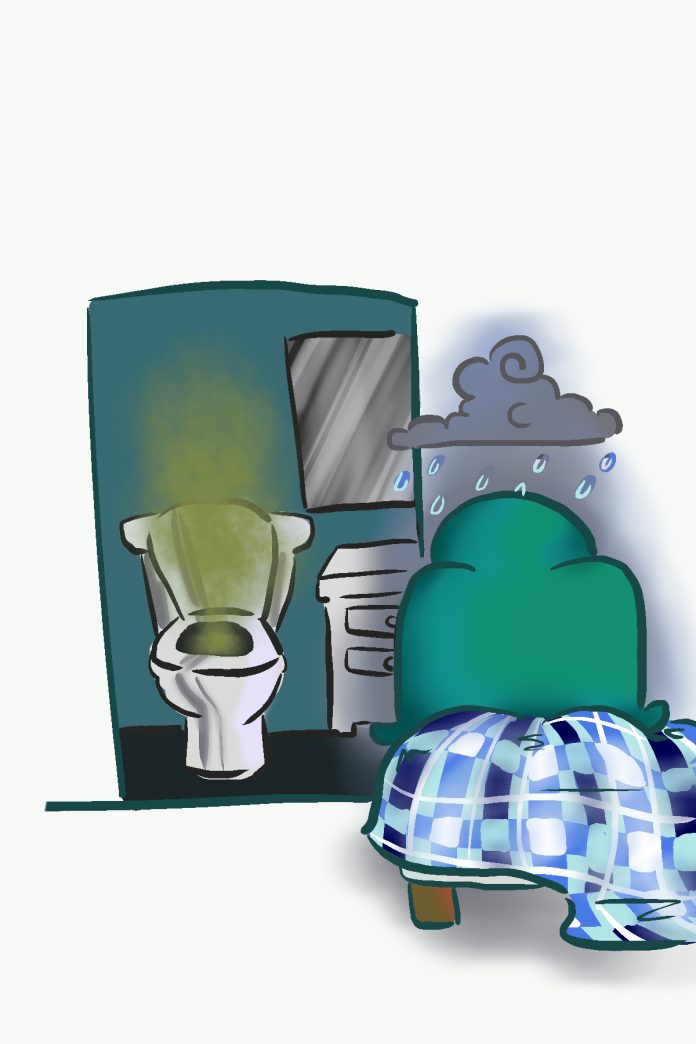It might be a convenient location, but it’s not a place where you want to stay too long. I lived in SFU residence for three years of my undergraduate degree, and the best decision I made was to move off the mountain.
For someone like myself who arrived in Metro Vancouver without knowing anyone, residence did provide friendships that have endured throughout my degree. However, beyond the social aspect, my experience in the single-dorm, shared-everything buildings that make up the bulk of housing options was less than ideal.
I lived with the other first years in the Towers on the mandatory meal plan before moving into Shell House which boasts shared kitchen facilities. Though finally being able to cook was a big improvement from the Dining Hall food, it didn’t change the discomfort of living in close quarters with many other students in an outdated building.
Like others, I stayed because housing is hard to come by on a student budget and being steps from Burnaby classes is rather convenient. Yet there are some elements that I found problematic, and that finally led to my decision to leave campus living for good last year.
The Dining Hall
As someone with dietary restrictions, I know that my experience with dining hall food represents the worst-case scenario. I had already accepted my housing offer by the time I became aware of the severity of my food allergies.
Most first-year students are restricted by their age to the Towers, which have no cooking facilities beyond a microwave in the common room. I was no exception, and I received verbal assurances from the Dining Hall management at the time that they had accommodated people with my condition before.
Perhaps the food was adequate for those who were not limited by sensitivities or preferences or did not follow religious dietary guidelines. However, the food available to me and many others regularly lacked necessary nutrition groups.
There were stovetops available in the Dining Hall for students and limited ingredients for cooking, but this did not increase my options.
My physical health took a downturn while living in first-year residences. The whole experience ended up being rather expensive as I bought healthier options myself to keep in my room.
Noisy neighbours
There were a couple consistencies that persisted throughout the years, namely noisy neighbours and door-slammers. The problem of noise complaints never wavered for the community advisors in charge either.
In the Towers, the doors were so heavy that the sound would rattle the whole side of the floor unless one made a concerted effort to guide the latch into place. It was the same story for the doors leading outside and to the showers in latter years.
Though it might seem like an easy fix, most of my neighbours never quite got the hang of closing the door quietly. The repeated warnings given by community advisors didn’t seem to have an impact.
The paper-thin walls meant that sound travelled from the kitchen, the hallways, and other rooms whenever someone was having a lively conversation or a rowdy (weekday) night. It makes for an environment that is not a great fit for everyone.
Gross bathrooms
It is perhaps not surprising that bathrooms shared by a whole floor are rather disgusting on a regular basis. Between hair clogging the shower drain, feces in the shower (I’m not kidding), and projectile vomit covering the bathroom floor, I’ve seen it all.
If these spectacular examples of grossness don’t do it for you, certain shower stalls appeared not to have been cleaned by staff for weeks prior to my submissions requesting that the situation be remedied.
This is the nature of living with numerous, and generally unaccountable, individuals. The community advisors attempted to enforce the rules around cleanliness, but they regularly went ignored.
The kitchens
Needless to say, it is not easy to share a kitchen with a floor either. I was lucky enough to be situated close to the kitchen, but, some residents had to travel from other parts of the building to use the facilities.
Limited storage meant that most food items and cooking supplies were often at least partially stored in rooms. That is, if they weren’t forgotten for months on the kitchen counters or under the sink . . .
Fire alarms
It doesn’t matter the time of day or night, there is no escape from the multitude of fire alarms in residence. The alarms are usually caused by unsupervised cooking or 2 a.m. microwave fiascos. Who knew popcorn was so difficult to make?
I found that being jarred from sleep in the early morning hours or rushing straight outside from the shower was a standard routine. However, safety protocols meant that we could not re-enter the building until a fire truck arrived on scene, occasionally taking upwards of half an hour.
While the sensitive alarms are certainly justified, a good night’s sleep before a midterm exam is not guaranteed.
The choice is yours, make it wisely
The setup of most residence buildings are not something that is the right fit for every student. It’s something to keep in mind if you are considering whether to enter — or stay — in residence.




